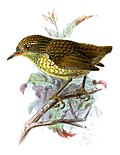Taxonomy
The genus name Amytornis was coined in 1885 by the Norwegian born zoologist Leonhard Stejneger as a replacement for Amytis that had been introduced in 1831 by the French naturalist René Lesson. [1] [2] [3] The name Amytis was pre-occupied as it had been used in 1822 by the French zoologist Marie Jules César Savigny for a group of annelid worms. [3] [4] As Lesson had listed two species in his new genus but had not specified a type, the type was designated by the English zoologist George Gray in 1841 as Malurus textilis Quoy and Gaimard, the western grasswren. [5] The replacement name Amytornis combines the genus Amytis that had been introduced by Lesson with the Ancient Greek ορνις/ornis, ορνιθος/ornithos meaning "bird". [6] Amytis was the daughter of the Median king Astyages, and the wife of Cyrus II. [7]
Amytornis is the only genus classified within the subfamily Amytornithinae, and form a separate clade to the related fairy-wrens and emu-wrens within the family Maluridae. The genus contains 14 species, many of which are poorly known due to their secretive nature and remote and inaccessible habitat.
Extant species
The genus contains the following 14 species: [8]
This page is based on this
Wikipedia article Text is available under the
CC BY-SA 4.0 license; additional terms may apply.
Images, videos and audio are available under their respective licenses.











